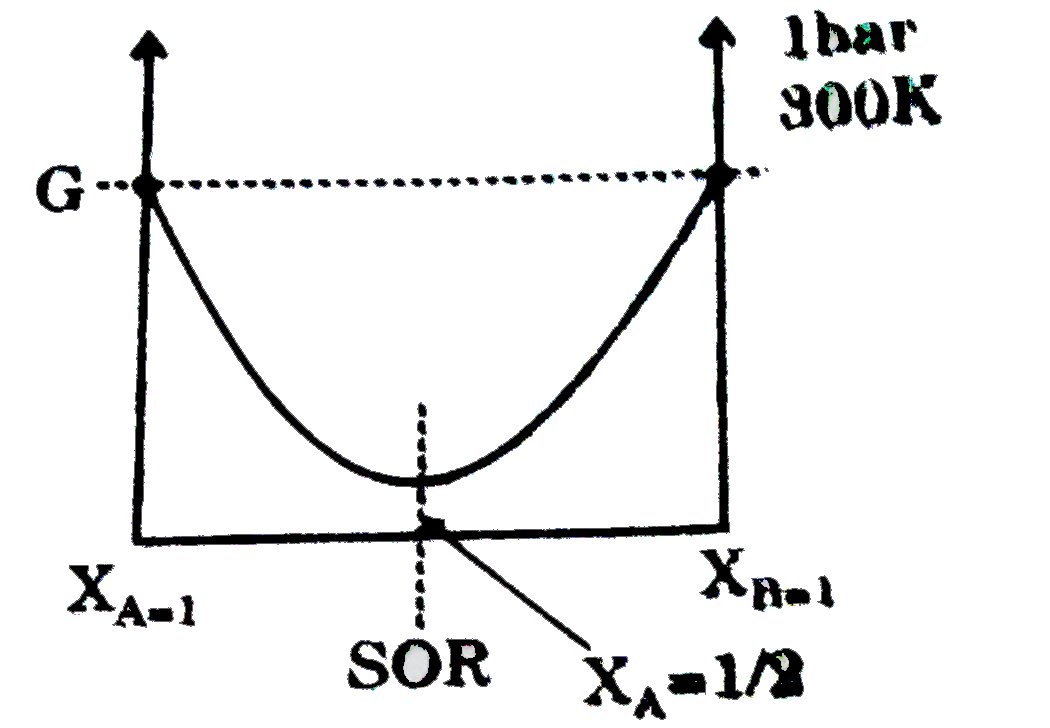Which of the following can help to predict the rate of reaction if the standard Gibb's free energy of reaction (ΔrG∘) is known ?
Equilibrium constant
ΔrH∘
ΔrU∘
Heat liberated during the course of reaction in calorimeter
The correct Answer is:A
To solve the question regarding which factor can help predict the rate of reaction if the standard Gibbs free energy of reaction (Δ_rG^@) is known, we can follow these steps:
1. Understanding Gibbs Free Energy (Δ_rG^@):
- The standard Gibbs free energy change (Δ_rG^@) is a thermodynamic quantity that indicates the spontaneity of a reaction at standard conditions. A negative Δ_rG^@ suggests that the reaction is spontaneous, while a positive value indicates non-spontaneity.
2. Relation Between Δ_rG^@ and Equilibrium Constant (K):
- The relationship between the standard Gibbs free energy change and the equilibrium constant is given by the equation:
ΔrG@=−RTlnK
where R is the universal gas constant and T is the temperature in Kelvin. This equation shows that if we know Δ_rG^@, we can calculate the equilibrium constant (K).
3. Predicting Reaction Rate:
- The equilibrium constant (K) is a measure of the extent of a reaction at equilibrium. While Δ_rG^@ provides information about spontaneity, K gives insight into the concentrations of reactants and products at equilibrium.
- A larger K value indicates a reaction that favors products, which can correlate with a faster reaction rate under certain conditions.
4. Conclusion:
- Therefore, knowing the standard Gibbs free energy change (Δ_rG^@) allows us to determine the equilibrium constant (K), which can help predict the rate of reaction.
Final Answer:
The correct option is equilibrium constant (K).
---
- The standard Gibbs free energy change (Δ_rG^@) is a thermodynamic quantity that indicates the spontaneity of a reaction at standard conditions. A negative Δ_rG^@ suggests that the reaction is spontaneous, while a positive value indicates non-spontaneity.
- The relationship between the standard Gibbs free energy change and the equilibrium constant is given by the equation:
ΔrG@=−RTlnK
where R is the universal gas constant and T is the temperature in Kelvin. This equation shows that if we know Δ_rG^@, we can calculate the equilibrium constant (K).
- The equilibrium constant (K) is a measure of the extent of a reaction at equilibrium. While Δ_rG^@ provides information about spontaneity, K gives insight into the concentrations of reactants and products at equilibrium.
- A larger K value indicates a reaction that favors products, which can correlate with a faster reaction rate under certain conditions.
- Therefore, knowing the standard Gibbs free energy change (Δ_rG^@) allows us to determine the equilibrium constant (K), which can help predict the rate of reaction.
The correct option is equilibrium constant (K).
Topper's Solved these Questions
Similar Questions
Knowledge Check
The equilibrium constant of a reaction is 0.008 at 298K. The standard free energy change of the reaction at the same temperture is
A+11.96 kJB-11.96 kJC-5.43 kJD-8.46 kJFor the equilibrium reaction, the value of Gibbs free energy change is:
A>0B<0C=0D≠0In order to perdict variation of Gibbs free energy with progress of reaction at constant temperature and 1 bar pressure, it is important to know realtive stability of the components involved in chemical reaction at standard useful work then the change in Gibbs free energy should be calculated
Which of the following options correctly represects the graph between Gibbs free energy (G0 and state of reaction (SOR) at 1 bar and 300 K for the reaction But -1 ene (A) ⇔ but -2 ene (B)
A B
B C
C D
D
2nd Law of thermodynamics | Spontaneity of a reaction | Gibbs free energy
View SolutionWhich of the following are false about Gibbs free energy?
View SolutionIn which of the following reactions,standard reaction entropy change(ΔS∘)is positive and standard Gibb,s energy change(ΔG∘)decreases sharply with increasing temperature?
View SolutionWhich of the following statements is incorrect ? Standard Gibbs free energy change is always zero at equilibrium
View SolutionIf equilibrium constant for a reaction is K, then standard free energy change is :
View Solution
